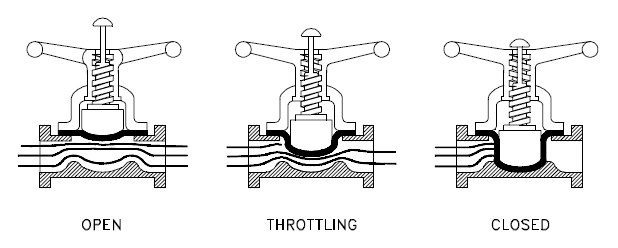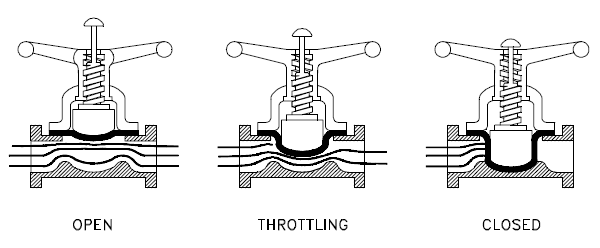
A diaphragm valve aka a membrane valve is a type of linear motion valve with wide application in cutting off or regulating fluid flow. It has been around for centuries now since its invention and use by the Greeks to adjust both the temperature and as we as the flow of water into the hot baths.
The ancient Greek diaphragm valve was manually operated with the diaphragm being forced to seals over a weir and put the valve in a closed position. The modern version of the valve was popularised by P.K Saunders, a South African mining engineer and consists of the following component parts:
• A valve body with ports
• An elastomeric diaphragm/membrane
• A saddle or seat upon which the membrane seals the valve.
Working Principle of Diaphragm Valves
Precision control is achieved when the elastomeric diaphragm membrane is stretched over the piping using an actuator. The fluid pathway is therefore made narrow for high pressure output or even the completely blocked to cut off the flow effectively. Modern sanitary diaphragm valves can be manually operated or even automated as well
In manual maneuver, the diaphragm has a stud through which it is connected to a compressor. When the compressor is maneuvered using the valve stem, the diaphragm lifts or presses against the valve seat or weir to effectively block the piping. In open position, the valve stem moves up, so the diaphragm moves from the fluid pathway.
In an automated operation, pneumatic, electric or hydraulic actuators stretch the membrane over or away from the fluid pathway when specific logics are well achieved.
Designs of Diaphragm Valves
Based on the application you want – on & off or even the flow control – you can choose between The Straight-through Diaphragm Valve or the Saddle Diaphragm Valve, the lined or unlined diaphragm valves.
• The straight-through design
The membrane presses against the valve seat. The bottom of the valve is contoured for a straight-through flow. These types of valves are suitable in both on-off applications.
• The Saddle design
The diaphragm presses over a weir. These types of valves provide excellent throttling and are suitable for control applications to modify the presence of pressure, flow rates, temperature, and liquid levels as well.
• The lined & unlined diaphragm valves design
Based on the chemical composition of the media you want to control and the temperature setting of the operation, you can select between lined or unlined valve bodies. Stuffed valve bodies make use of the rubber or polymers to reduce the rate of friction, abrasion and also to increase longevity
The modern diaphragm valve is deemed an ultra-high purity valve because of the no dead-angle design and corrosion-resistant polymers used for the sealing materials and diaphragm. It is designed to support high pressure of up to 14 bars and extreme -40℃– 200℃ temperature operations. Here’s a look at features of modern diaphragm valves:
Features of Modern Diaphragm Valves
• A Wide-ranging Selection of Chemically Inert Polymers
The diaphragm material is chemically inert plastics such as PTFE, PFA and PFA or rubbers such as EPDM, Leather, Silicone or NBR. Such inert materials make the valves suitable in applications requiring the maintenance of media purity and corrosion protection.
PTFE is a fluorocarbon that can be molded into various shape and configurations. It is also chemically inert hence resistant to multiple chemicals in the media being controlled. It can also withstand high heats making the valve suitable for delivering millions of cycles in extreme temperature applications.
PFA is a copolymer with fluorocarbon chain too but resistant to temperatures over a wider range than PTFE. PFA is also available in various grades of cleanliness and purity so you can pick what is suitable for your sanitary needs.
• Field Replaceable Seats
The modern design features replaceable seats so that you can fit the seat you want to achieve desired flow characteristics. Field replaceable seats make it easier to switch between the saddle and straight-through flows.
• Steel or Plastic Body Type
Most valves bodies are engineered from stainless steel alloys such as cast iron, ductile iron. Alloy 20 and more that are chemically inert too and resistant to corrosion. The steel body makes the valves durable and fit for rough operation settings. You can also get plastic body type featuring PTFE, PVC-C, PP. ABS or even more chemically inert polymers.
• Body Lining
Body lining is used to eliminate internal crevices and keep off medium from corroding and interfering with the valve’s internal parts integrity. Based on your operation temperature and chemical settings, you can select from the unlined or lined valve types. Commonly used lining materials include the rubber, fluorine plastic, and glass.
• Modular Design for Compatibility with Various Systems
The valve body is designed according to Manufacturers Standardisation Society (MSS) SP-88 or ANSI B16.10 standards, making them interchangeable and even compatible. Diaphragm valves body design with the above standards are interchangeable with other valves such as solid wedge valves, double-disc valves, short term plugs, and sanitary ball valves.
• Actuators and Intelligent Controllers
Modern diaphragm valves feature automation features such as pneumatic, electric or hydraulic actuators. Additional accessories such as positioners, limit switches, and solenoid valves are used to simplify valve operations.
The pneumatically actuated diaphragm valve is the most common type of valves. Air pressure is channeled int the actuator via a pilot valve, the actuator, in turn, raises the diaphragm to open the valves. Pneumatic actuators are suitable for high-speed operations as compared with hydraulic actuators.
• Multi-port System
The standard diaphragm valves are a 2/2-way system, but in a modern design, you can find the multi-port valves such as the T-valves that features a 3/2-way system. Diaphragm valves with more than two ports make use of more diaphragm seats too.
• Sanitary Design
You can also get diaphragm valves suitable for various sanitary applications. They use of FDA approved diaphragm materials, no dead-angle design and cleaned polished internal surfaces with Ra < 0.13m. Such diaphragm valves are suitable for use in the biopharmaceutical, food & beverage or personal care industry.
What Is a Diaphragm Valve Suitable for?
Corrosive applications because it is easy to select the diaphragm material based on chemical
compatibility.
Abrasive applications where the body lining is engineered to withstand abrasive media and the diaphragm is designed to be easily replaced once it is worn out.
Solid entrained liquids and slurries as the diaphragm can seal around the entrained solids and provide tight sealing.
The only con of diaphragm valves is that they are limited to work under 14 bars of working pressure and below 204℃ operating temperature as well. It is hard to find diaphragm valves surpassing these standards. Additionally, the hydrostatic pressure you can apply to the diaphragm is quite more limited. But apart from these two cons, diaphragm valves are simple to operate, maintain, and suitable for those corrosive and abrasive media, other valves types won’t handle.
